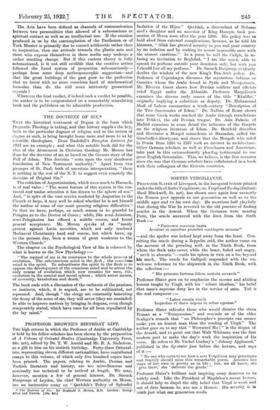PROFESSOR BROWNE'S BIRTHDAY GIFT.
Tire high esteem in which the Professor of Arabic at Cambridge is held by his fellow-scholars has been shown by the preparation of A Volume of Oriental Studies (Cambridge University Press, 84s. net), edited by Dr. T. W. Arnold and Mr. R. A. Nicholson, as a gift to him on his sixtieth birthday. Forty-three Oriental- ists, representing eleven different nationalities, have contributed essays to this volume, of which only five hundred copies have been printed. The papers, relating to Arabic, Persian and Turkish literature and history, are too miscellaneous and nominally too technical to be noticed at length. We may, however, mention a few of general interest. Dr. Snouck Hurgronje of Leyden, the chief Western authority on Mecca, has an instructive essay on " Qatfulah's Policy of Splendid
• The Doctrine- of Bin. By Reginald S. lioxon, B.D. London : George Allen and Linwin. LI0a. 634 Isolation of the Hijaz." Qat5dah, a descendant of Moham- med's daughter and an ancestor of King Huseyn, took pos- session of Mecca soon after the year 1200. His policy was to hold aloof from external complications, because, as he told his kinsmen, "Allah has granted security to you and your country by its isolation and by making its access impossible save with the utmost exertions." In a poem he told the Caliph, in re- fusing an invitation to Baghdad, "I am like musk, able to spread its perfume outside your dominion only, but with you I should lose all my perfume." Dr. Snouck Ilurgronje evidently doubts the wisdom of the new King's Pan-Arab policy. Dr. Pedersen of Copenhagen discusses the mysterious Sabians or Gnostics whom the Arabs found in Syria and Mesopotamia. Mr. Rhuven Guest shows how Persian soldiers and officials ruled Egypt under the Abba.sids. Professor Margollouth examines the diverse early senses of the title " Khalifat," originally implying a substitute or deputy. Dr. Muhammad Shad of Lahore summarizes a tenth-century "Description of the Two Sanctuaries of Islam." Dr. Nallino of Rome shows that some Greek works reached the Arabs through tmnslaticins into Pehlevi, the old Persian tongue. Dr. Asin Palacio of Madrid examines in some detail the influence of the Gospels on the religious literature of Islam. Dr. Herzfeld describes and illustrates a Mongol mausoleum at Hamadan, called the Gumbadh-i-Alawiyyan, and shows that the Mongols who ruled in Persia from 1265 to 1337 took an interest in architecture. Other German scholars, as well as Frenchmen and Americans, take part in this extraordinarily pleaztag testimonial to our great English Orientalist. This, we believe, is the first occasion since the war that German scholars have collaborated in a book with their colleagues of the Entente countries.


































 Previous page
Previous page